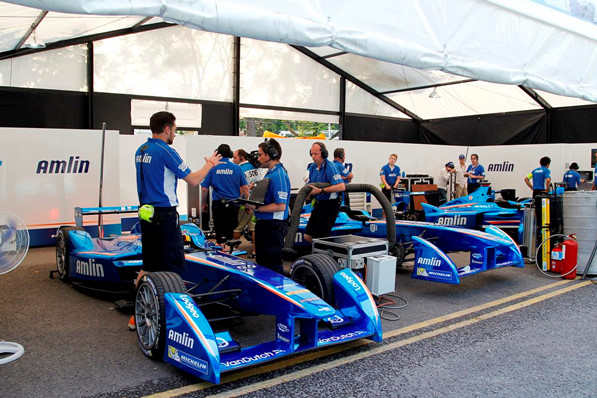The grand challenge of electric motor racing
 |
| Spark-Renault SRT_01E's |
Spark Racing Technology technical director Theophile Gouzin has played a key role in the Spark-Renault SRT_01E's development.
Now, four months after the maiden FIA Formula E season kicked off in Beijing, the Frenchman offers a thorough overview of the project's advancement.
WHAT HURDLES DID YOU FACE WHEN THE PROJECT WAS LAUNCHED?
Car manufacturers had already built many electrical systems when we started working on the Spark-Renault SRT_01E. However, our goal was not to come up with copycat ideas but to instead meet brand new requirements, namely designing a fully-electric single-seater that could be fitted with different powertrains.
Our team took up a hugely stimulating, albeit unprecedented, challenge and we were given free rein in our initiatives. Starting from scratch we had to invent new concepts, be it in the field of chassis design or battery integration. Gathering a group of renowned technical partners like Williams, Renault, McLaren, Michelin, and Dallara undoubtedly proved crucial in ensuring that the project was on the right track.
[adinserter name="GOOGLE AD"]HOW DOES THE COOPERATION BETWEEN SPARK AND YOUR CUSTOMER TEAMS WORK?
The teams are very keen on heeding our recommendations and we assist them all year long by studying aero data, providing safety information, etc. We aimed at getting to grips with this entirely new environment while simultaneously offering a high-quality service, which includes thorough training for the car.
Every Formula E round actually allows each squad to help us a great deal as they gather valuable data on track. In the same way, they need our expertise in order to fully understand the potential issues that may arise during the races. Every single outfit has a lot of questions and we make a point of working hand in hand with them.
HOW DO YOU EXPLAIN PEOPLE'S APPETITE FOR THE SERIES?
First, we must acknowledge that the official promoter has done a superb job. The overall message appeals to fans because it brings up attractive notions like modernity and sustainable development. These assets make the championship easier to market to sponsors and commercial partners, especially in a field like motor racing.
Formula E's significance has also drawn manufacturers and elite drivers, hence the truly exceptional entry list we have. As for the show on track, street circuits offer plenty of action and drama, which certainly make for thrilling races. Having been designed as an open championship, the series can also boast an exciting future. A lot of constructors and companies have already expressed a positive interest in the project, so we're off to an auspicious start!
WHAT ARE THE INITIAL PITFALLS YOU'VE HAD TO OVERCOME SINCE THE SEASON STARTED?
 |
| Electric Motor |
It's been very satisfying to see the Spark-Renault SRT_01E make its competitive racing debut. It meant that all the hard teamwork we'd put in since the project's inception came to fruition. Of course, we've experienced the usual teething problems inherent of such young technology, with some parts – mainly to do with the suspension – breaking. But we have been poring over the data ever since in a bid to improve the car's overall reliability.
What's more, bumpy and uneven street circuits add further stress and strain as the vibration puts the SRT_01E under duress. These issues will nonetheless enable us to make headway and boost the need for major 2015 upgrades. While working on the current car, we are already planning ahead for next year and must define which areas of the powertrain should be further developed. The chassis is definitely a thoroughbred, so our priority now is to optimize the new technologies that are implemented in our single-seater.
WHAT CONTRIBUTION CAN SPARK RACING TECHNOLOGY MAKE TO REGULAR ROAD-GOING VEHICLES?
[adinserter name="GOOGLE AD"]We are currently putting our in-house technologies through their paces. Motorsport offers a fantastic platform in which to experiment under extreme conditions. This allows us to fully understand how our systems work while also enabling us to improve them.
Energy management has gradually become a major aspect in racing, as underlined by the F1-bred KERS or WEC's new hybrid technologies. In the future, investment will mainly target battery development in order to increase its autonomy and performance. I can then see this technology being seamlessly transferred onto road cars.
